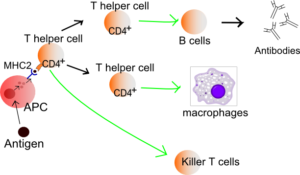[retweet][facebook]
Researchers conclude that acupuncture benefits the immune system. In a controlled laboratory experiment, Hubei University of Chinese Medicine researchers discovered that electroacupuncture stimulation of acupuncture point ST36 (Zusanli) “enhanced the level of immune cytokines and splenic CD4+ T cells through TRPV channels.” In addition, the researchers document that electroacupuncture applied to ST36 enhances serum interferon-γ (IFN-γ) levels, interleukin (IL)-2, and IL-17. Results were confirmed using immunohistochemical analysis.
The research measured the effects of electroacupuncture and precisely identified that electroacupuncture at ST36 enhances cytokines, which are proteins secreted by cells that have a specific effect on the interactions and communications between cells. The researchers discovered that electroacupuncture enhancement of cytokines and helper T cells (CD4+ T cells) is through TRPV (transient receptor potential vanilloid) channels. TRPV channels are cellular sensors for a broad variety of physical and chemical stimuli involved in the formation of visual and auditory sensations, touch, olfactory perception, taste, temperature, and algesia. TRPV involvement in cell signaling triggers host cell responses to “benign or harmful environmental changes.”
 The findings are significant because CD4+ T cells are of paramount importance in human immune systems. These cells are referred to as helper T cells and are active in the immune system’s defense against microbes, including viruses. CD4+ T cells have the ability to differentiate into many different types of cell subsets in the body’s effort to activate immune system cells, immunoregulation, and cytotoxic defense mechanisms.
The findings are significant because CD4+ T cells are of paramount importance in human immune systems. These cells are referred to as helper T cells and are active in the immune system’s defense against microbes, including viruses. CD4+ T cells have the ability to differentiate into many different types of cell subsets in the body’s effort to activate immune system cells, immunoregulation, and cytotoxic defense mechanisms.
The research reveals the role of electroacupuncture (2–15 Hz) in the enhancement of CD4+ T cells through TRPV channels, indicating an important pathway of acupuncture’s effective action. The researchers add, “These results proved that the rise in the intracellular Ca2+ induced by electroacupuncture at the ST36 acupoint was responsible for the differentiation, proliferation and activation of splenic CD4+ T cells.”
The researchers conclude, “the present study has demonstrated that electroacupuncture at the ST36 acupoint was able to regulate the production of immune cytokines (IFN-γ , IL-2 and IL-17) and the differentiation and activation of splenic T cells, which was mediated by the regulation of extracellular and intracellular Ca2+ concentrations.” The investigation was made possible by cooperation between three Hubei University of Chinese Medicine departments: Department of Biochemistry, Department of Anatomy, Department of Pathogenic Biology.
The use of ST36 for the treatment of diseases in Traditional Chinese Medicine (TCM), according to the researchers, “has a long history of use as a supplementary therapy.” The research supports the efficaciousness of traditional ST36 applications and maps the pathways and effective actions of needling ST36 when stimulated with an electroacupuncture device. This sheds light on the fundamental scientific question, how does acupuncture work? The researchers document that acupuncture achieves therapeutic results by Ca2+ signaling “in the context of T cell activation and differentiation.”
The research team notes that the investigation was prompted by results from prior investigations finding acupuncture effective in the treatment of stress induced immunodeficiency. They add that the impetus for the investigation was also supported by prior research finding electroacupuncture stimulation of ST36 effective in activating the immune system and benefitting patients receiving anti-cancer therapy. They added that an increased understanding of the “curative mechanisms of electroacupuncture” will help to expand the uses of the procedure on a greater scale.
The researchers used modern techniques to measure the effects of electroacupuncture. Flow cytometry was used to measure the Ca2+ concentration of spleen cells. Immunofluorescence was integral to the immunohistochemical analysis. Ultrasonication was required for homogenates and an “ELISA assay was used to assess the IFN-γ, IL-2 and IL-17 levels in the serum and extracts from the ST36 acupoint area.”
The research is a quintessential laboratory investigation serving to more greatly understand ancient Traditional Chinese Medicine (TCM) in modern terms; specifically, the role of acupuncture point ST36 in reference to immune system enhancement. Traditionally, ST36 is known for its ability to tonify qi, nourish blood and yin, activate the channels, benefit source qi, and alleviate pain. The investigation updates this understanding with specific, quantifiable, and repeatable biochemical changes elicited by electroacupuncture stimulation of ST36.
ST36 has long been an important acupuncture point in TCM. In approximately 440 CE, imperial medical officer Qin Cheng-zu stated that “all diseases can be treated” with the application of ST36. During the Han Dynasty (206 BCE–220 CE), the Chinese physician Hua Tuo applied ST36 for the treatment of the five taxations: excessive use of the eyes injuring the blood, excessive lying down injuring the qi, excessive sitting injuring the flesh, excessive standing injuring the bones, excessive walking injuring the sinews. These are but two historical examples for the uses of ST36. Now, with the advent of the Hubei University of Chinese Medicine research, we can add that ST36 enhances the immune system, stimulates production of helper T cells, and promotes cytokines.
Excerpt from:
